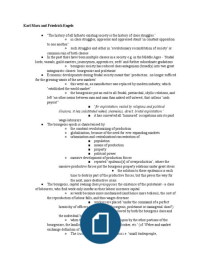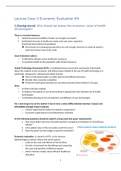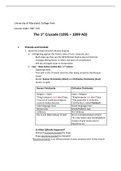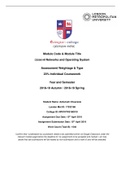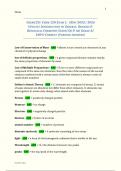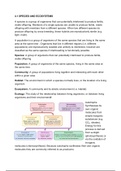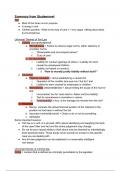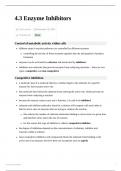Karl Marx and Friedrich Engels
● ‘The history of all hitherto existing society is the history of class struggles.’
○ in class struggles, oppressor and oppressed stand ‘in constant opposition
to one another’
○ such struggles end either in ‘revolutionary reconstitution of society’ or
common ruin of both classes
● In the past there have been multiple classes in a society e.g. in the Middle Ages - ‘feudal
lords, vassals, guild-masters, journeymen, apprentices, serfs’ and further subordinate gradations
○ bourgeois society has reduced class antagonism (broadly) into two great
antagonistic classes: bourgeoisie and proletariat
● Economic developments during feudal society meant that ‘production...no longer sufficed
for the growing wants of the new markets’
○ this went on, as manufacture was replaced by modern industry, which
‘established the world market’
○ the bourgeoisie put an end to all feudal, patriarchal, idyllic relations, and
left ‘no other nexus between man and man than naked self-interest, that callous ‘cash
payout’’
■ ‘for exploitation, veiled by religious and political
illusions, it has substituted naked, shameless, direct, brutal exploitation.’
■ it has converted all ‘honoured’ occupations into its paid
wage-labourers
● The bourgeois epoch is characterised by:
○ the constant revolutionizing of production
○ globalization, because of the need for ever expanding markets
○ urbanization and centralization/concentration of:
■ population
■ means of production
■ property
■ political power
○ massive development of production forces
■ repeated ‘epidemic[s] of overproduction’, where the
massive productive forces put the bourgeois property relations under great stress
● the solution to these epidemics is each
time to destroy part of the productive forces, but this paves the way for
the next, more destructive crisis
● The bourgeois, capital owning class presupposes the existence of the proletariat - a class
of labourers, who find work only insofar as their labour increases capital
○ as work becomes more mechanised (and hence more tedious), the cost of
the reproduction of labour falls, and thus wages decrease
■ workers are placed ‘under the command of a perfect
hierarchy of officers and sergeants’ (bourgeois, proletariat or managerial class?)
■ they are thus enslaved by both the bourgeois class and
the individual bourgeois manager
○ when the worker is paid, ‘he is set upon by the other portions of the
bourgeoisie, the landlord, the shopkeeper, the pawnbroker, etc.’ (cf. Weber and market
exchange definition of class)
○ The lower strata of the middle class i.e. ‘small tradespeople,
● ‘The history of all hitherto existing society is the history of class struggles.’
○ in class struggles, oppressor and oppressed stand ‘in constant opposition
to one another’
○ such struggles end either in ‘revolutionary reconstitution of society’ or
common ruin of both classes
● In the past there have been multiple classes in a society e.g. in the Middle Ages - ‘feudal
lords, vassals, guild-masters, journeymen, apprentices, serfs’ and further subordinate gradations
○ bourgeois society has reduced class antagonism (broadly) into two great
antagonistic classes: bourgeoisie and proletariat
● Economic developments during feudal society meant that ‘production...no longer sufficed
for the growing wants of the new markets’
○ this went on, as manufacture was replaced by modern industry, which
‘established the world market’
○ the bourgeoisie put an end to all feudal, patriarchal, idyllic relations, and
left ‘no other nexus between man and man than naked self-interest, that callous ‘cash
payout’’
■ ‘for exploitation, veiled by religious and political
illusions, it has substituted naked, shameless, direct, brutal exploitation.’
■ it has converted all ‘honoured’ occupations into its paid
wage-labourers
● The bourgeois epoch is characterised by:
○ the constant revolutionizing of production
○ globalization, because of the need for ever expanding markets
○ urbanization and centralization/concentration of:
■ population
■ means of production
■ property
■ political power
○ massive development of production forces
■ repeated ‘epidemic[s] of overproduction’, where the
massive productive forces put the bourgeois property relations under great stress
● the solution to these epidemics is each
time to destroy part of the productive forces, but this paves the way for
the next, more destructive crisis
● The bourgeois, capital owning class presupposes the existence of the proletariat - a class
of labourers, who find work only insofar as their labour increases capital
○ as work becomes more mechanised (and hence more tedious), the cost of
the reproduction of labour falls, and thus wages decrease
■ workers are placed ‘under the command of a perfect
hierarchy of officers and sergeants’ (bourgeois, proletariat or managerial class?)
■ they are thus enslaved by both the bourgeois class and
the individual bourgeois manager
○ when the worker is paid, ‘he is set upon by the other portions of the
bourgeoisie, the landlord, the shopkeeper, the pawnbroker, etc.’ (cf. Weber and market
exchange definition of class)
○ The lower strata of the middle class i.e. ‘small tradespeople,

